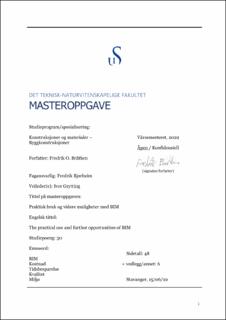| dc.description.abstract | Digitalization is and have been central for some time now, and this is also represented in part by BIM in the building, construction, and property. The need for a more efficient and cost reduced sector is constant for this industry as well. To reach this goal, the industry is always on the lookout for better solutions to the problems that is presented.
This thesis will seek to provide additional information regarding BIM beyond the 3D-model. The information will include whether the integration of 4D-10D is a viable and smart in prospect to the additional cost, time, and the quality management within the content of this thesis.
To better help understand the results and the theme of the thesis, it will include a heading about the theory behind the different dimensions in BIM. The theory will consist of general information regarding the thesis. Furthermore, it will also include a comparison between two different projects, one which did not use BIM and one which did. The reason for this, is to see if there are any benefits regarding time, cost, and quality. The comparison is done subjectively through interviewee and in this thesis.
The part which includes the interview, is done with the goal to include the practical usage of the different dimensions in the industry, through the eyes of a relevant person within the project. The interviews will be about projects which used different BIM dimensions, for the sake of variation and to cover more.
The interview and the comparison of the older projects will then be compared to the theory. This is done to see whether the theory is similar to the experience provided by the interviewee and the construction projects.
The results will cover whether this is a viable investment regarding time, cost, and quality through the experience from the interviewee and their projects. This will also provide an insight into their view regarding additional dimensions, and which of those that are viable.
The part which includes the discussion will partly be included in the results and in the summary as its own chapter after the results. The summary at the end will consist of more overall discussion provided from the results.
Afterwards, the conclusion will consist of the finishing thoughts regarding the subject of the thesis. There will also be provided a suggestion in terms of further research within this field.
It is important to stress that this thesis only covers a marginal part of the industry, as information is only collected from a small part of sources. This does not necessary mean that the conclusion and results is fitting to other projects.
At the end of the thesis, the transcribed interviews will be attached. | |
